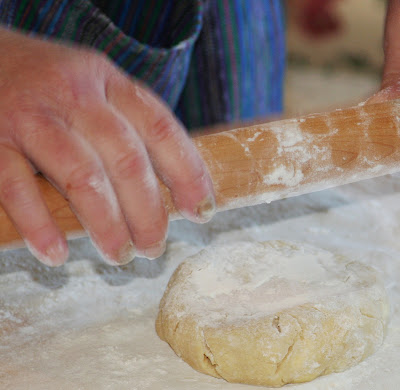I adore all things British. I came out as an Anglophile many years ago, back in the Princess Di days. My Christmas china is from England. My stove and pots and pans are from England. I even went there once. (Well, my plane touched down at Heathrow briefly en route to Italy. Does that count?) I subscribe to British magazines and fantasize about living in some quaintly picturesque English village where I'll take tea every afternoon and use words like loo and nappy and jumper. I'll work in a charmingly cozy English bookstore. I'll stroll through ambrosial gardens in my wellies and know the name of every David Austin rose. These are the things I daydream about. What I do not daydream about is English food. I mean, why would I? What with their bland boiled cabbages, blood puddings, and baked beans on toast, it's no wonder they spend all their time drinking in pubs. They've had to make up delightfully vague names like bubble & squeak and spotted dick and toad-in-the-hole to distract people into thinking the food is edible. They can't even manage dessert. One word: Fruitcake. Just saying.Nope, absolutely no interest in British food. Which means no interest in British cookbooks. So when I say I've never met a cookbook I didn't like, this does not apply to British cookbooks. They don't count. They don't even rate a mention on the cookbook scale. Hence, when I bought a cookbook stand for my English country kitchen, I was presented with a real dilemma. Obviously nothing but an English cookbook would do. But any book that suggested ruining a perfectly good steak by adding kidneys certainly was not worthy. And steak and kidney pie is pretty much in every English cookbook ever written. Isn't it?One day I was browsing the cookbook section in our charmingly cozy local bookstore when I happened upon Jamie Oliver. I had heard of Jamie. He was that scrawny blonde bloke who cooked up boring British fare.But here he was looking out at me from the cover of his latest book, Cook with Jamie, My Guide to Making You a Better Cook, out just in time for Christmas. Wow! Jamie had grown up. Filled out. And he was lookin' good in that t-shirt of his. Oh, yeah, I'm pretty sure he was looking straight at me. And I was looking back. Right then and there I decided I wanted to keep trading meaningful glances with Jamie and that he would be the chosen one to grace my cookbook stand. Straight onto my Christmas list went that cookbook while I counted off the days on my Advent calendar til Jamie could join me in the kitchen.
December 25th finally arrived and I tore off the wrapping and set Jamie carefully on the cookbook stand in my English country kitchen. Perfection. Jamie and I exchanged a few soulful looks at each other as I went about my Christmas activities the rest of that day, and over the next few busy days he and I settled into a flirtatious conviviality. Life was merry indeed!Things eventually slowed down enough that I found myself with a few minutes to spare, which inevitably led to me and Jamie snuggled up together on the couch. Just a peek under his covers, so to speak, was what I had in mind. Cuz I really didn't think I was going to be all that interested in his brain. And that's when I discovered – Jamie Oliver is not just a pretty face. Jolliver (as I've taken to calling him) clearly knows food and is passionate about it. And he wants us to be passionate about it too.Jamie's writing mirrors his cooking – straightforward and completely genuine. His manner, like his recipes, is easy and honest. With this book, he's taken on the challenge of making all of us better cooks, and he knows better than to bombard. He's simply taken seven categories—salads; pasta, gnocchi and risotto; meat; fish; vegetables; desserts; and some 'bits and bobs'—and goes into just enough depth to educate without overwhelming.For instance, in the third chapter, he delves into risotto. He talks a little about risotto, gives the basic risotto recipe, and then gives 8 mouth-watering variations (thankfully none involve kidneys), each with yummy photos. There's no way after reading that section that one would not be inspired to rush right into the kitchen to whip up one of these risottos and maybe even improvise using their own favorite ingredients. And thanks to Jamie's guidance, one can do so confidently.Jamie is one of the good guys. All the profits from this book go to his Fifteen Foundation which inspires and trains young cooks from all over the world, giving them a much-needed chance of making it in the culinary world.It's been several years now since that fateful Christmas. Jamie's still keeping me company in the kitchen and gazing out at me with his Mona Lisa smile. And I am definitely a better cook for it.
Squash Risotto, Jolliver Style
3 pints vegetable or chicken broth , divided
2 T olive oil
8 T butter, divided
1 large onion, finely chopped
4-5 stalks celery, finely chopped
1 lb 6 oz arborio rice
9 fl oz dry white wine
1 medium squash
1 T marscarpone cheese
7 T butter
1-2 handfuls grated parmesan cheese
sage leaves
bacon, cut into small pieces and fried til crisp
Cut the squash in half, scoop out the seeds, brush with oil, and roast at 450 degrees until done. When done, cool and scrape the flesh from the skin; then set side.

While the squash is roasting, bring the stock to a simmer and keep hot.
In a large pan, heat the olive oil and 1 T butter. Add the onion and celery and cook over low heat for about 15 minutes until soft. Stir in the rice and then the wine.
Add 1-3/4 pints of the stock a bit at a time, stirring and waiting until the liquid is absorbed before adding more. Keep the heat medium low. You don't want the rice to cook too quickly or too slowly. It should take about 15 minutes to add in the first portion of stock.
At this point, you can cool the risotto and set it aside or store it in the fridge until ready to continue. When you are ready to continue, heat the remaining 1-1/4 pint of stock. Put about one half of that into a large pot and add in the risotto mixture. Continue adding the remaining stock a little at a time, again stirring between additions until the liquid is absorbed before adding more.
Toward the end, you can add in whatever flavors you want, in this case the squash. After all the liquid is added and absorbed, remove from the heat and add the marscarpone cheese, remaining 7 T butter, and parmesan cheese.
Fry the sage leaves in a bit of olive oil until crisp and drain.
Finish the risotto by stirring in the bacon and crumbling the sage on top.











































































